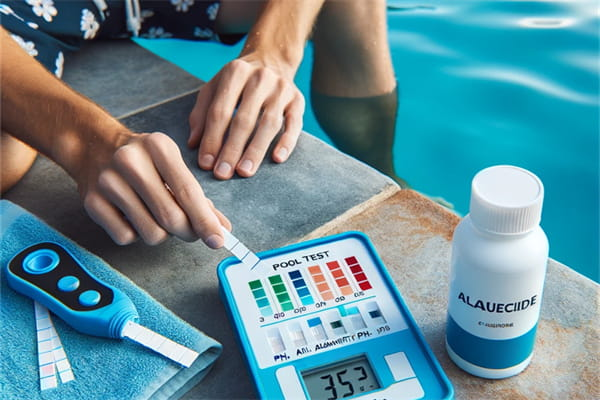When it comes to maintaining a crystal-clear pool, algaecide is an indispensable tool in your arsenal. However, using algaecide safely and effectively requires more than just a casual understanding of the product. Proper handling, application, and storage are crucial to ensure not only the efficacy of the algaecide but also the safety of those around you. In this blog post, we’ll explore the essential precautions to take when using algaecide, providing you with a thorough guide to keep your pool pristine and your household safe.

Understanding Algaecide
Algaecide is a chemical treatment designed to kill and prevent algae growth in swimming pools, ponds, and other water bodies. Algae can turn your sparkling pool into a murky mess, affecting water quality and potentially clogging filters. Algaecide works by disrupting the cellular processes of algae, effectively eliminating it from your pool. However, due to its chemical nature, handling algaecide requires careful attention to detail.
1. Read the Label and Instructions
The first and foremost step in using algaecide safely is to thoroughly read the product label and instructions. Each algaecide formulation can have different active ingredients, concentrations, and application methods. Here’s why this step is critical:
Manufacturer Guidelines: The label provides specific instructions on dosage, application frequency, and safety precautions. Following these guidelines ensures that the algaecide works as intended.
Product Knowledge: Understanding the type of algaecide you’re using (e.g., copper-based, quaternary ammonium compounds, or polyquats) helps you tailor your approach and avoid potential complications.
2. Use Personal Protective Equipment (PPE)
Algaecide is a chemical, and direct contact can pose health risks. Always wear appropriate personal protective equipment (PPE) to safeguard yourself:
Gloves: Chemical-resistant gloves protect your hands from potential irritation or burns.
Eye Protection: Safety goggles or glasses shield your eyes from splashes.
Clothing: Wear long sleeves and pants to minimize skin exposure. A chemical-resistant apron can offer additional protection if necessary.
3. Handle with Care
When handling algaecide, caution is paramount to avoid spills and accidents:
Avoid Spills: Carefully pour and measure the algaecide to prevent spills. Use a dedicated measuring cup or device.
Proper Mixing: If the product requires dilution, always add algaecide to water, not the other way around. This method reduces the risk of splashing and chemical reactions.
4. Ensure Proper Ventilation
Algaecide fumes can be hazardous if inhaled in large quantities. Always use algaecide in well-ventilated areas:
Outdoor Application: Apply algaecide outdoors or in open spaces to ensure good airflow.
Avoid Windy Conditions: Wind can carry algaecide particles, increasing the risk of inhalation or spreading the chemical to unintended areas. Choose calm days for application.
5. Monitor Pool Chemistry
Regularly testing and maintaining your pool’s chemical balance is crucial for effective algaecide use:
Regular Testing: Test your pool water frequently to ensure balanced pH, alkalinity, and chlorine levels. Unbalanced water can reduce the effectiveness of algaecide.
Adjust Dosage: Based on test results and pool conditions, adjust the algaecide dosage as recommended by the manufacturer.

6. Avoid Mixing with Other Chemicals
Mixing chemicals can cause dangerous reactions. Always handle algaecide separately:
No Mixing: Never mix algaecide with other pool chemicals unless explicitly directed by the manufacturer.
Sequential Application: If multiple treatments are necessary, apply them separately and follow the waiting periods recommended by each product.
7. Observe Weather Conditions
Weather plays a significant role in the application of algaecide:
Rain and Sunlight: Apply algaecide when there is no forecast for rain, which can dilute the treatment. Also, avoid direct sunlight during application if the product is UV-sensitive.
8. Follow Up and Maintenance
Even after the initial application, ongoing maintenance is essential:
Regular Cleaning: Maintain regular cleaning and filtration to support the algaecide’s effectiveness.
Monitor Algae Growth: Keep an eye on any algae resurgence and reapply algaecide as necessary, following the recommended frequency.
Conclusion
Using algaecide safely and effectively is crucial for maintaining a clean and healthy pool environment. By reading the product label, using personal protective equipment, handling the chemical with care, ensuring proper ventilation, keeping it away from children and pets, considering environmental impacts, monitoring pool chemistry, avoiding chemical mixing, observing weather conditions, and committing to regular maintenance, you can enjoy a pristine pool without compromising safety.

 Instant
Quote
Instant
Quote Email
Us
Email
Us